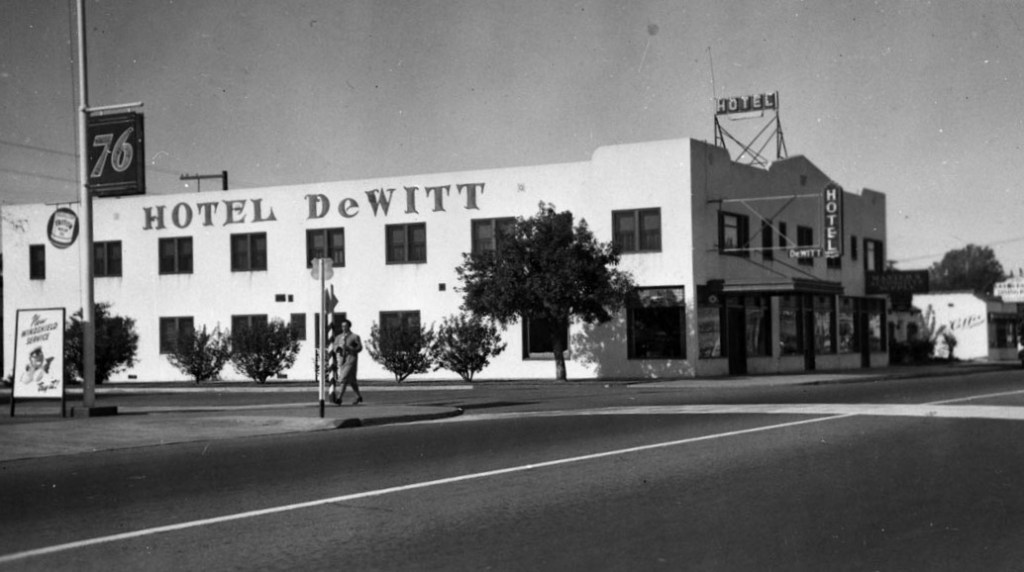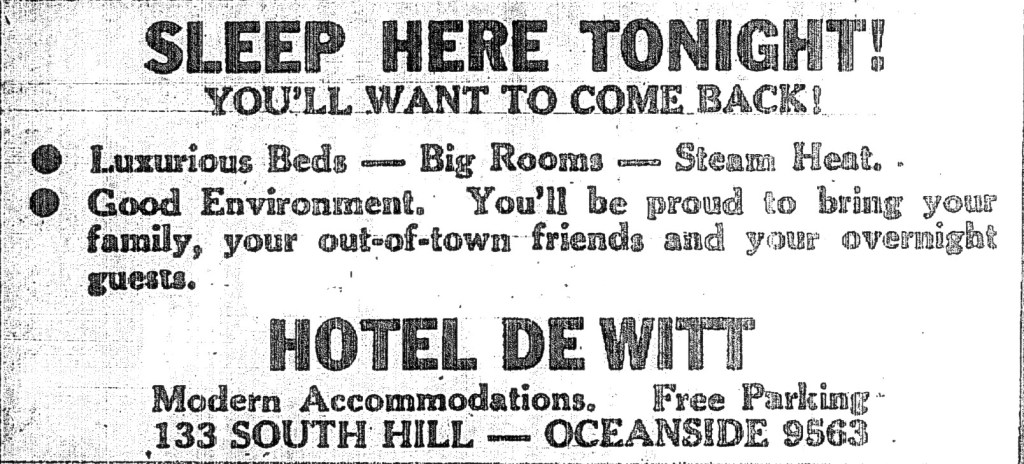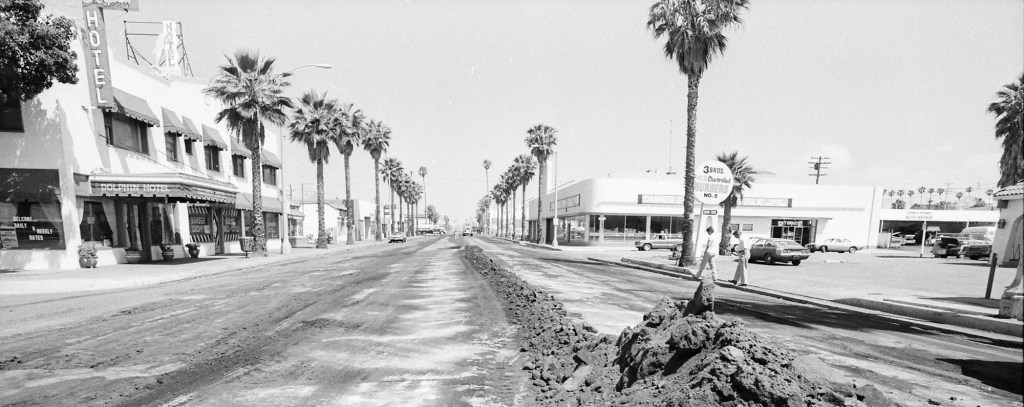Before Julius E. Keisker purchased the property on the northwest corner of Topeka and Hill Streets (Coast Highway), Edward and Mamie Fairchild had hiredC. G. Rieke to build a new home at the site. But just two years after their home was built, a real estate deal was made and the Fairchild residence was moved to the corner of Ditmar and Michigan Streets, where it remains today. With the lot cleared, Keisker was ready to build a new hotel which would bear his name.

The Blade newspaper described the proposed hotel in 1926: “Plans are now being drawn for Mr. Keisker for a stucco building of two stories 66×100 feet in dimensions, with thirty-two sleeping rooms above, and a lobby and two store rooms on the first floor. It is the expectation that very shortly bids can be asked for the erection of the new building, which the owner plans to make an attractive addition to the hotel buildings of the city. The approximate cost the improvement is stated to be about $140,000.”
In January of 1927 the newspaper reported that: “Work is now going on for the foundation of a hotel building which is to be erected by J. E. Keisker on Hill street near California. The building will be 70 x 100 and of two stories. The lower floor will be divided into a large store room and a lobby. Upstairs will be 26 sleeping rooms. The building is to be of heavy frame and stucco and will be heated by steam, a very necessary convenience demanded by the traveling public. The construction work is being done by O. M. Wallace.”

When the hotel opened in June of 1927 a grand opening was held and headlines read: “Keisker Hotel Open to Guests”. The Oceanside Blade announced:
With a public reception Friday evening the fine new Keisker hotel on Hill Street near California formally opened its doors for guests. A large crowd of well-wishers from this entire section attended the opening. Dancing was enjoyed until a late hour and punch and wafers were served.
The new hostelry contains twenty-six rooms all handsomely furnished, comfortable and home-like. The rooms are quite large averaging 180 square feet and many are provided with private baths, several being ensuite. Downstairs is a spacious lobby with large plate glass windows on two sides and handsomely finished in brown jazz plaster. The lobby is furnished in wicker and a handsome writing desk and other furnishing add to the provision for the comfort and convenience of guests.
Steam heat, and hot and cold water in every room is provided for with a hot water plant and automatic distillate furnace located in the basement. A call system and other modern equipment are installed and every convenience provided for the proper operation of the hotel.
Adjoining the lobby downstairs is a large store room which will be leased. The outside appearance of the building is enhanced by Moorish awnings over the upstairs windows and a handsome glass marquee over the front entrance bearing the name of the hotel. An electric sign on the roof is visible at a long distance and the hotel building makes a handsome addition to that section of the city.
In the construction and furnishing of the hotel some of the local firms participating were the Berg Electric Co.; Oceanside Furniture & Hardware Co.; A. E. Franklin, plumber; H. W. Maddux, Rock Gas; Glen Titrell, plastering; R. H. Simmons, cement contractor; O. M. Wallace, general contractor; James H. Campbell, lathing; Hayward Lumber Co., lumber; Fred Franks, painting; and Central Roofing Co., roofing.
In 1930 the hotel’s flooring was replaced by multi-colored tile, “almost exactly like the flooring in the Agua Caliente Hotel, Agua Caliente, Mexico.” The Oceanside Blade stated that this new feature proved “that Agua Caliente has nothing on Oceanside in the way of hotels, at least.”
As the hotel was located on the 101 Highway between Los Angeles and San Diego, (and all the way to Mexico), it was a popular spot for the traveling public. Well to do clientele, including notables associated with Hollywood and the movie industry frequented the hotel, especially those on their way down to enjoy, purchase and even transport alcohol during the Prohibition years.
In 1934 the hotel was purchased by Robert and Jessie DeWitt, who in turn renamed the building as the Hotel DeWitt. Jessie DeWitt was a noted artist and a member of the San Diego Artists Association, Women Painters of the West, Laguna Beach Artists Association, La Jolla Artist Guild and the Carlsbad-Oceanside Art League.

With the establishment of Marine Corps Base Camp Pendleton in 1942, Oceanside grew dramatically. With thousands of Marines arriving to train and 5,000 civilians to aid in construction and support, Oceanside was the nearest town to accommodate the great influx of people. The City was hard pressed to meet the essentials the military and civilian personnel demanded with restaurants, schools and hotels bursting at the seams. The Southern California Telephone Company had to enlarge 4 times in four years to keep pace with the mounting demands. The business office was moved to the DeWitt Hotel to accommodate workers.
The hotel was sold in 1950 to Mr. and Mrs. Orville T. Schwarz of San Marino. The hotel was managed by their son Elman. Soon after, the hotel’s name was changed to the Dolphin Hotel. In 1953, the S&S Cafeteria opened hotel building, operated by George H. Swain and Robert H. Stevens.
A new highway was built in 1954 diverting traffic from downtown Oceanside. Newer motels with parking and more complete amenities were in demand. Because of its antiquated features, namely its lack of ensuite bathroom facilities, it fell out of favor with tourists and eventually the condition of the hotel deteriorated.

In the late 1970s the hotel was purchased and renovated by a trio of enthusiastic owners, Richard Rogers, Barbara Werle Rogers (movie, television and stage actress) and Paul Griesgraber. They filled the rooms with antiques and gave them names such as the Polynesian Room, the Hollywood Room and the Bridal Suite.

But by the 1980s the hotel was renting for $22.95 a day or $115 a week. Its clientele were not tourists and its reputation was “seedy.” The hotel’s glory days seemed a distant memory, and there was no one left to remember when it was a gem on the Highway 101.

Everyone loves a great comeback story and the Dolphin Hotel has been reborn –from the inside out. Rooms have been completely reconfigured and rebuilt, not just refurbished, giving guests the hotel experience they expect and demand with a downtown vibe only Oceanside can give.
The Fin, a nod to the Dolphin, has made this vintage hotel building retro cool. Its back with style, flavor and a cool new mural. Julius Keisker would be proud to see his hotel still serving the traveling public, vibrant and alive. The Switchboard Restaurant and Bar is a popular eatery housed in the same building. Its name pays homage to the telephone workers who occupied the hotel in the 1940s. What’s old is new again!

My parents were married in Oceanside in 1953. My dad was a corpsman in the Navy stationed at Camp Pendleton.
LikeLiked by 1 person
I enjoyed reading your posst
LikeLiked by 1 person